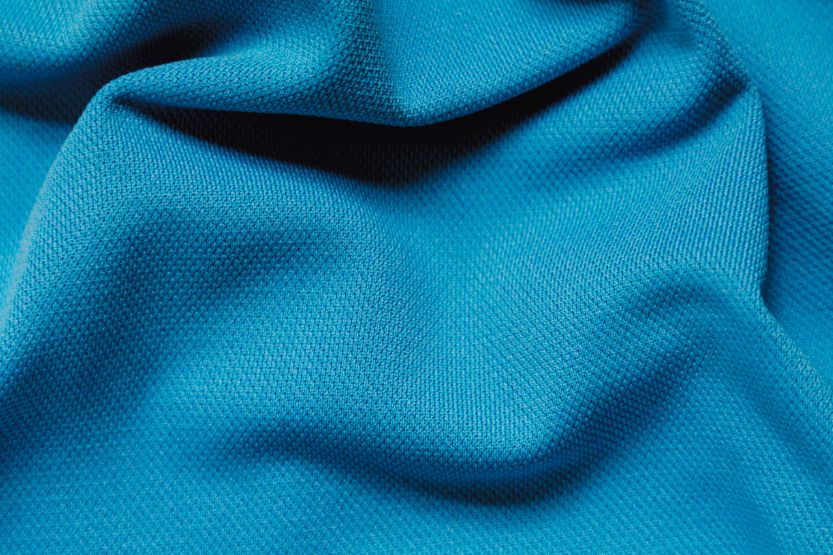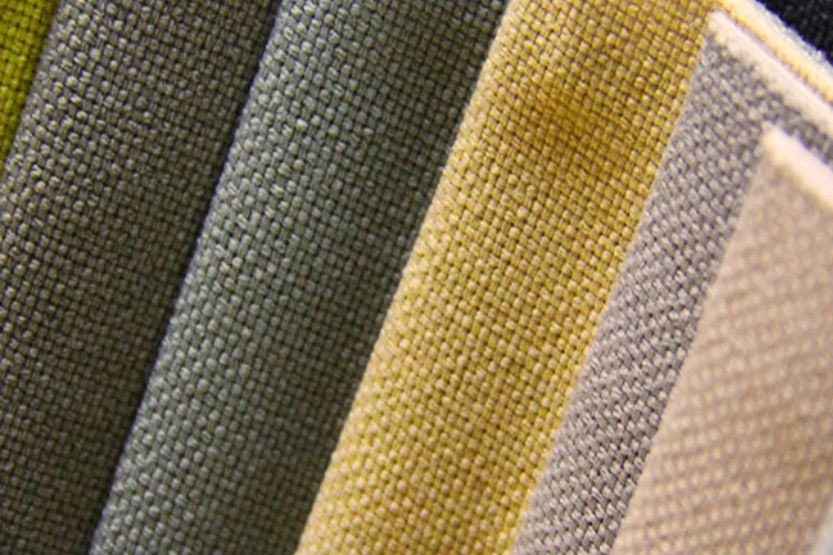Polyester is a popular synthetic fabric, making it an excellent option for shirts, jeans, and other clothing items. Before buying, however, there is one thing you are probably curious about – is polyester stretchy?
Polyester is a stretchy fabric. It becomes more stretchy when combined with flexible natural materials like cotton and rayon. The level of stretch can also differ depending on how the fabric is made. Knitting the threads will give it more stretch than weaving.
Read on the learn more about if polyester is stretchy or not.
What Is Polyester?

A Fabric Derived from Fossil Fuels and Organic Sources
Before anything else, let us first talk about what polyester is. By being knowledgeable of the composition of the fabric, it will be easier for you to understand its stretchability.
Polyethylene terephthalate, more popularly known as polyester, is a fabric derived from fossil fuels and organic sources. It is a product of mixing ethylene glycol and terephthalic acid.
Can Come from Eco-friendly Alternatives
This type of plastic is most commonly derived from petroleum. Although, recent innovations made it possible to create polyester from eco-friendly alternatives, including crops and recycled plastic.
One of the biggest issues about polyester is that it is made using a non-renewable resource. It is a part of the petrochemicals industry, which has a bad rap because of its social and environmental implications.
Can Resist Wrinkles, Stain, and More
Nonetheless, polyester is also sustainable, specifically from the perspective of its users. It is long-lasting. It can resist sunlight, stain, and wrinkles, damaging the fabric. Additionally, it requires minimal energy and water to wash polyester.
So, Is Polyester Stretchy?
Yes, polyester is stretchy!
However, it is not a simple yes or no answer. While it is stretchy, several factors can influence such, including the specific materials blended for polyester.
Also, take note that there are different levels of stretchability. For instance, it can stretch a bit after wearing but will regain its original shape immediately. Others, meanwhile, stretch after washing and will cause a change in the original size.
As an artificial material, polyester is designed to stretch naturally. This means that when you move, it can stretch with your body so you won’t feel cramped.
It will immediately snap back to its original shape, depending on the polyester type, which you will learn more about in the next section.
Types of Polyester
1. 100% Polyester
Yes, a 100% polyester fabric will stretch, but only to a minimal degree. However, such is only temporary, such as when wearing the clothes.
The pressure that you exert will cause the fabric to stretch for a moment. Nonetheless, it will soon return to its original size and shape. More so, if you are exercising or moving aggressively, it will also stretch, making it comfortable.
If you are looking for clothes or fabrics that are more stretchable, then you should opt for polyester blends or poly blends. As the name implies, it is polyester mixed with various materials, including those we’ll discuss below.
2. Poly-Cotton
A blend of synthetic polyester and natural cotton, poly-cotton is a common material used for medical scrubs, as well as bedsheets and pillowcases. It gives users the best of both worlds, offering benefits such as durability, wrinkle resistance, and cost.
However, it also has several drawbacks. It will not thrive in high temperatures, making it unsuitable for outdoor use.
Poly-cotton is a stretchy material. It has a higher level of stretchiness than cotton but less than polyester. The stretchability depends on its specific composition. If there is more polyester than cotton, then it is less likely to stretch.
3. Spandex and Polyester
Spandex is another common fabric blended with polyester. It is a synthetic and lightweight fabric known for its elasticity. Some might assume that spandex is a brand name, but it isn’t. Instead, it refers to polyether-polyurea copolymer fabric.
Spandex can stretch up to eight times on its own compared to its original size. With such, when combined with polyester, the fabric blend will stretch.
The more spandex there is, the more the fabric will stretch. Because of this, it is a popular choice for active wear since you will need clothes that stretch as you move to be more comfortable.
4. Tri-Blend
In fabric construction, tri-blend combines polyester, cotton, and rayon. We discussed polyester and cotton earlier, so let’s briefly discuss rayon.
The primary material used in rayon is purified cellulose fibers, often from wood pulp. While it is a natural material, chemicals are required for processing, making it a semi-synthetic fabric.
Rayon and cotton are two materials that are known for their stretchability. So, if you combine it with polyester, the tri-blend fabric will be stretchy, even if it is not as stretchy as the two. The more cotton and rayon there is, the more stretchy the fabric will be.
Knitted vs. Woven Polyester

In discussing the stretchability of polyester, you must consider one more thing – whether the fabric is knitted or woven:
Woven Polyester Fabric
Making a woven polyester fabric requires weaving two yarns or threads wherein one goes horizontally across the width of the other. Meanwhile, the other thread goes vertically on the length of the other fabric.
The result is a crisscross pattern. They are prone to wrinkling. Plus, they can easily unravel unless there is a zigzag stitch as a finish.
Knitted Polyester
On the other hand, knitting polyester is done through a single strand continuously looping through itself. Because of the interlocking loops, they will not easily unravel, especially on the edges. Although, they can be prone to curling.
Between the two, knit is more prone to stretching. The thread loops provide more flexibility, making it a great option if you want form-fitting attire. By contrast, weaving polyester gives it more structure, which minimizes the possibility of stretching.
Although whether the fabric is made through knitting or weaving, the biggest influence on stretchability will be the combination of the materials present.
How Do You Make Polyester Looser?
Many instances will require stretching polyester clothes. For instance, you might have a favorite shirt that has shrunk over time and want to return it to its original size. Here are some of the best ways to stretch polyester if that’s the case:
1. Use Hair Conditioner
A hair conditioner is present in almost every home, making it an easily accessible material if you need to stretch polyester clothes. This is a good option for knits.
We also love this method because it leaves a nice scent on clothes, depending on your conditioner. In the same way that a conditioner can soften hair, it can also soften fabrics, allowing them to stretch a bit.
Fill the Sink with Warm Water
To start, turn the faucet and wait until the water is warm. Do not use water that is too hot as it can damage polyester. Once it reaches the desired temperature, lower the sink’s stopper. Fill the sink with water until it can cover the cloth you want to stretch.
Add Conditioner
The amount of conditioner to add will depend on the size or number of clothes you want to stretch or the water in the sink. The general recommendation is to use one tablespoon of conditioner for one quart of water.
Soak the Cloth
Soak the cloth you want to stretch with the water and conditioner ready. Submerge it completely in the sink and let it rest for up to half an hour. It will relax the tense threads so they will stretch. After about half an hour, the water will start to get cooler, so it will no longer have an effect.
Wring Out Water
Take the cloth out the sink and wring out as much water as possible. Exert as much force as you can to stretch the fabric. If it contains wool and cotton, among other materials, avoid wringing the cloth too much as it can damage the fabric.
Hand-Stretch to the Desired Size
With water wrung out of the cloth, it is time to stretch the fabric to the size you desire. When you are happy with the size, use heavy objects like books to pull the shirt. Keep them on as you wait for it to dry.
2. Mold It to Your Body
Molding the polyester cloth to your body is another great way to stretch it. This is good if you want to ensure that your size is right. Unlike the earlier mentioned way of stretching polyester, this option can give your clothes a better fit:
Wash the Cloth
The first step is to wash your polyester cloth. We recommend following what we discussed earlier, using a hair conditioner and warm water for best results. The warmth of the water will make it easier for the fibers to stretch.
Wear It
After washing, the next step is to put the cloth. Wring but do not dry. Wear while the fabric is still wet. This will give the cloth the time to fit on your form so you can achieve the desired size.
Move to Loosen the Fabric
Move while you are wearing the polyester shirt. Raise your hands a few times. Bend, twist, and lean. Doing different movements will allow the fabric to expand so that it will loosen. You can even do a short stretching exercise or yoga routine.
Wait Until It Dries
Do not remove your shirt too soon. We recommend wearing it until the shirt dries to give it the best possible fit for your body.
3. Iron Polyester Cloth
Ironing is another effective solution for stretching polyester fabric. High temperatures will cause the fabric to stretch.
Put the Cloth in an Ironing Board
Lay down the cloth on an ironing board and spread it evenly. While doing s, preheat the iron to medium.
Spray with Water
Not just any water will do. Make sure that you are using warm water, which will increase the stretchability of polyester. Also, spray water on a towel until it is damp, then lay the towel on the top of polyester before you start ironing.
Flip the Cloth
Once you are done ironing one side, flip the cloth and start ironing the same way you did earlier. If the towel is already dry, spray it with water to make it damp.
Again, is polyester stretchy? Synthetic polyesters are not stretchy; they can retain shape and resist wear and tear, even when wet. But, natural polyesters are slightly stretchy.
How to Wash Polyester Clothes

Whether you have 100%, 95%, 50%, or any other percentage of polyester in clothes or even in beddings, it will have some stretch.
As mentioned, it stretches more with flexible materials, like cotton and spandex. Over time, the clothes can become bigger and will not look as good as new.
Proper washing is one of the most important in maintaining the peak condition of polyester clothing. This will help prevent the fabric from stretching. Here is a quick step-by-step guide on how to wash polyester:
1. Read the Label
The first thing to do is to check the label and religiously follow the instructions from the manufacturer. Not all polyester fabrics will require the same level of care. For instance, some will say “dry clean only.”
2. Turn the Clothes Upside Down
Before washing the clothes, turn them upside down. This will prevent snags. Otherwise, the threads can easily loosen, which will make them more prone to stretching. Not to mention, the fabric might end up being unsightly.
3. Pre-Treat Existing Stain
Start by pre-treating the fabric that you intend to wash. This is especially important if the fabric has a stain. Focus on areas like necklines, cuffs, and underarms. It is specifically prone to oil stains, as well as stains from deodorant. Spot treat the stain and let it sit for 15 minutes. Machine wash and dry.
4. Machine Wash
If there is no stain, you can proceed to machine washing polyester fabric. Most manufacturers of polyester clothes will recommend washing them in a normal cycle with either warm or cold water.
Avoid hot water as it can cause the fabric to break down, speeding up the wear of your clothes. Make sure that you are washing only those with similar colors and fabrics.
5. Dry Your Clothes
After machine-washing, let your clothes dry. Let it air dry, preferably in an area with the sun’s direct heat. Colored fabrics easily discolor with sun exposure.
If you want to tumble dry, choose the only medium temperature to prevent damaging the fabric. If you need to iron, do so at a low temperature. Good thing polyester seldom wrinkles.
6. Store Properly
Taking care of polyester clothing does not end after washing and drying. Proper storage is also crucial. Fold knit items when storing to prevent distorting and stretching. Meanwhile, you can hang woven items. Avoid storing in plastic as the clothes can be prone to mildew and can get yellow stains.
What Colors Can You Wash Together in the Washer
Frequently Asked Questions – Stretchability of Polyester
Does Polyester Stretch?
Yes, polyester stretches. The degree of stretchability, however, varies from one material to another. It stretches more if you combine it with flexible materials like cotton and rayon. The construction will also have an impact. Knitting polyester will give it more stretch compared to weaving.
Is 100% Polyester Stretchy?
Yes, 100% polyester is stretchy. Nonetheless, this synthetic material is not as stretchy as its natural counterparts, such as cotton or wool. Once it stretches, it will regain its natural shape after a while, making it more comfortable as it can follow your movements.
Is Polyester Stretchy in Jeans?
On its own, polyester in jeans will not stretch a lot. It will stretch for a bit but will quickly go back to its original shape. However, mixing it with materials like cotton or rayon will make jeans stretch more. The higher the percentage of these materials, the likelier the jeans will stretch.
Is Polyester and Elastane Stretchy?
When polyester combines with elastane, it becomes stretchy. It has more stretch compared to a fabric made of polyester. Even a small addition, such as 90% polyester and 10% elastane, will add stretch to the material.
Conclusion – Is Polyester Stretchy?
Yes, polyester is stretchy. This synthetic fiber has a natural stretch, but not much when it is on its own. If you want more stretch, you should choose polyester with natural materials.
Rayon and cotton, for instance, are known for adding flex to the fabric, making them more comfortable, especially when moving.
If you have polyester clothes that you want to be more stretchy, you can do a couple of things. For instance, you can soak it in a hair conditioner and water. Molding it to your body while the fabric is wet will also work. Another effective solution is ironing it while damp.


![Read more about the article What Is a Comfortable Dew Point? [Comfortable Dew Point Range]](https://howchimp.com/wp-content/uploads/2021/04/comfortable-dew-point-300x200.jpg)
